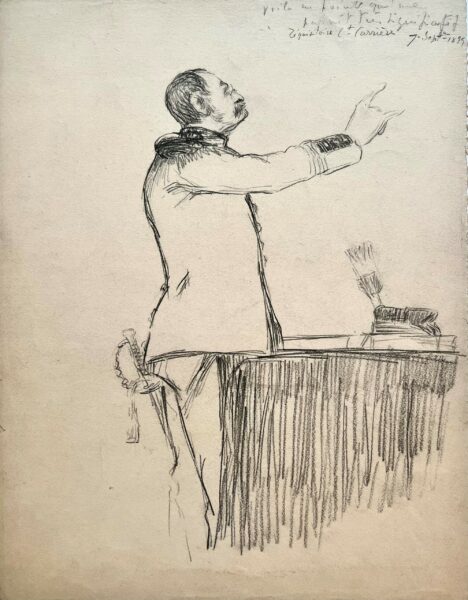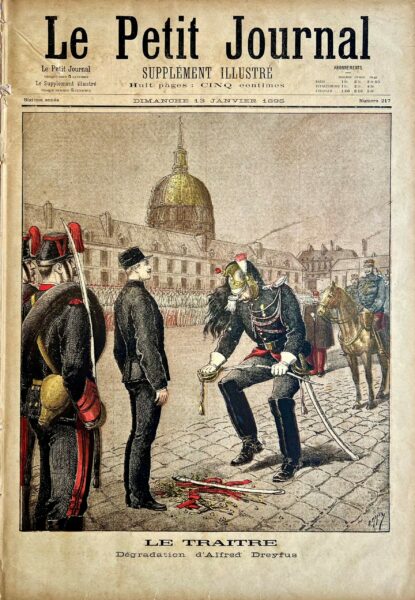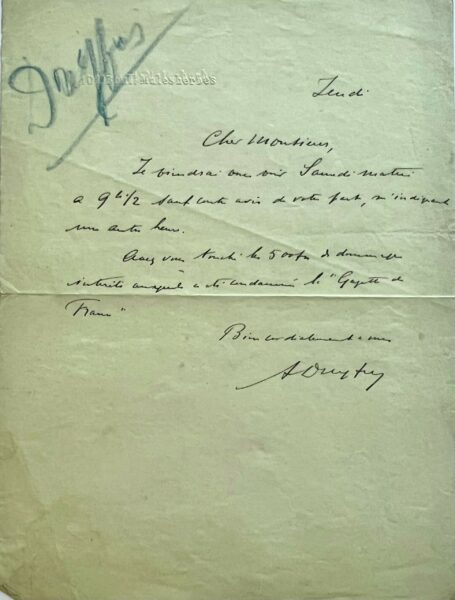[DREYFUS, AFFAIR.] BOUCHOR, JOSEPH-FÉLIX. (1853-1937). French artist known for his portraits. Drawing. 1p. Oblong Large 4to. (10½” x 14”). [Rennes, 1899]. Bouchor’s sympathetic, eyewitness pencil sketch of French journalist Séverine (Caroline Rémy, 1855-1929), a vocal supporter of Dreyfus, thoughtfully resting her chin on her hand as she observes the trial’s proceedings.
Alfred Dreyfus’ 1894 conviction for treason and his subsequent exile and imprisonment on the French Guiana penal colony Devil’s Island hinged on an intercepted memo, or bordereau, which revealed French military secrets that had been sent anonymously to the German embassy’s military attaché, Captain Schwartzkoppen, in Paris. The memo’s actual author was French Major Marie-Charles-Ferdinand Walsin-Esterhazy, a spy in German employ. Additional evidence, intended to implicate Dreyfus, was secretly forged and submitted by French Army officers to the military judges presiding over the proceedings.
The truth finally emerged in the summer of 1898 after Lieutenant Colonel Hubert-Joseph Henry confessed to his forgeries and killed himself in a military prison and Esterhazy fled to England. General Boisdeffre, the army’s Chief of the General Staff who had been convinced of Dreyfus’ guilt from the beginning, resigned after Henry’s confession. Considering these events, the court annulled the 1894 judgment against Dreyfus and granted him a second military trial in Rennes. Dreyfus, frail and in poor health, sailed from his island exile on June 9, 1899, to appear at the Rennes trial on August 7th.
Journalists and artists from around the world swarmed Rennes to observe the trial that would be “a culminating point of l’affaire. It was the last opportunity for the military system of justice to redeem itself… The first military tribunal [in 1894] had been able to insist that no hearings be conducted publicly. At Rennes, the second military tribunal held all hearings publicly, except for one, and the fact that the court insisted on holding any at all behind closed doors both exacerbated criticism of the proceedings and was hotly contested by the defense, for this time the eyes of the country and of the world were fixed on Rennes. The world press was ready to convict France if France convicted Dreyfus. And France itself, author of the Rights of Man and Citizens, country of the philosophes, and of the Enlightenment, was only too painfully aware of this,” (“The Military Trial at Rennes: Text and Subtext of the Dreyfus Affair,” Touro Law Review, Curran). The trial was covered in detail by newspapers and magazines worldwide and was even dramatized in Georges Méliès series of short silent films, produced concurrently with the trial to become the first ever film serial! (Nine of the eleven films can be viewed here: https://www.youtube.com/watch?v=Y3Re6Y1G8_U).
Of particular interest to the sketch artists and journalists covering the trial was their celebrated colleague, Séverine, who embraced Dreyfus’ cause after Emile Zola’s publication of “J’Accuse…!” and drew attention to Zola’s trial with her coverage “Notes of a Frondeuse” and her “Impressions of a Hearing.” Séverine founded and contributed to the pro-Dreyfus journal La Fronde, France’s first feminist newspaper. So taken was she with Dreyfus’ cause that “she baptized her house ‘Les Trois Marches,’ after the restaurant where the Dreyfusards would meet. In 1912, she stated, ‘Despite all of the insults and ingratitude, there is no other period of my life that I loved more than that one,’” (“Caroline Rémy dite Séverine,” Alfred Dreyfus: For or Against, http://www.dreyfus.culture.fr/en/bio/bio-html-caroline-remy-dite-severine.htm). Scholar Helen Rodney dubbed her “the High Priestess of Dreyfusism,” (“Séverine. Caroline Remy, la Grande Prêtesse du Dreyfusism (1855-1919),” L’Affaire Dreyfus de A à Z, ed. Drouin).
“By the time the Rennes trial took place, proof of his innocence abounded,” (The Affair: The Case of Alfred Dreyfus, Bredin). He was defended at court by Demange, who had been engaged by his family in 1894, and by prominent criminal attorney Ferdinand Labori, who had defended Emile Zola after his famous publication of J’Accuse…! One week into the trial, on August 14, Labori was shot in the back by a would-be assassin on his way to the courtroom. Though badly wounded, he returned to court on August 22. During the trial “Dreyfus spoke at length, and always confidently and with impressive specificity and precision, reconstituting events, showing how and why his accusers could not be telling the truth… On numerous occasions throughout the trial, he broke out in protest against the injustice and inaccuracy of testimony and, as he put it, its calumnious nature,” (op. cit., Curran).
On September 9, the judges, by a majority of five to two, found Dreyfus guilty of treason under the absurd concept “extenuating circumstances,” and sentenced him to ten years detention. Ten days later President Émile Loubet issued Dreyfus a pardon. Dreyfus, initially opposed to accepting any pardon as it would have compelled him to withdraw his petition for a legal revision and acknowledge responsibility for a crime he steadfastly maintained he never committed, finally agreed to acquiesce, providing he could continue to try to clear his name.
Séverine continued to fight for “Dreyfus’s rehabilitation to the point that in 1899 a Belgian newspaper dubbed her an ‘archi-Dreyfusophile.’ Before the Court of Cassation in 1904, she related how she had been shown the fake bordereau supposedly annotated by Wilhelm II,” (op. cit., Alfred Dreyfus: For or Against).
Despite the ongoing vitriolic attacks in the press and public displays by anti-Dreyfus elements, the Court of Cassation finally declared Dreyfus innocent 1906. The Dreyfus Affair’s significance is so far-reaching that the human rights movement, the origins of modern-day Zionism (Theodor Herzl was in Paris covering Dreyfus’ first trial for his Viennese newspaper), and the French separation of church and state can all claim to have been born during this dark chapter in French history.
Educated at the Beaux-Arts and an exhibitor at the Salon des Artistes Francis, Bouchor became known for his portraits of General John Pershing and French President Georges Clemenceau (a supporter of Dreyfus and publisher of Zola’s “J’Accuse…!”) as well as his illustrations of the American Expeditionary Forces in World War I and Orientalist paintings inspired by his travels in North Africa.
Provenance: Isabelle Lazar (nee Grumbacher), wife of Jewish journalist Bernard Lazare, anarchist, literary critic and one of Dreyfus’ earliest and most vocal defenders who covered the Rennes trial for The Chicago Record and The North American Review.
Some light wear, otherwise fine.





